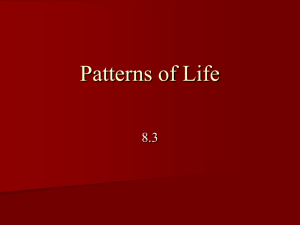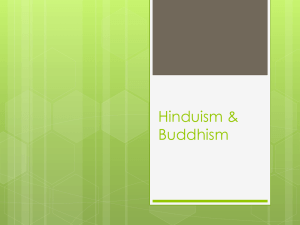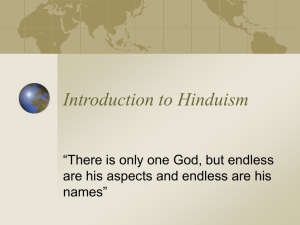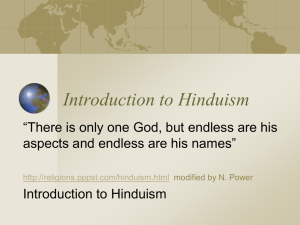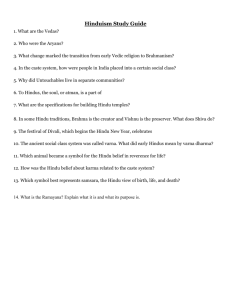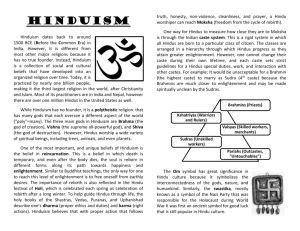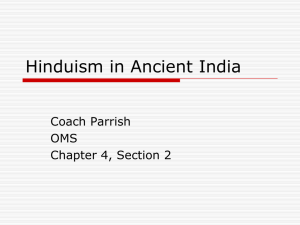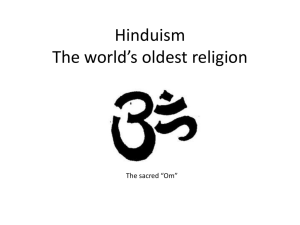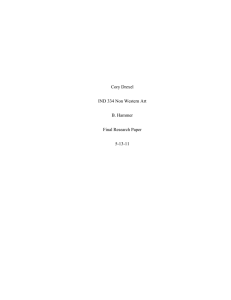The Hindu View of the World World History pages 61
advertisement
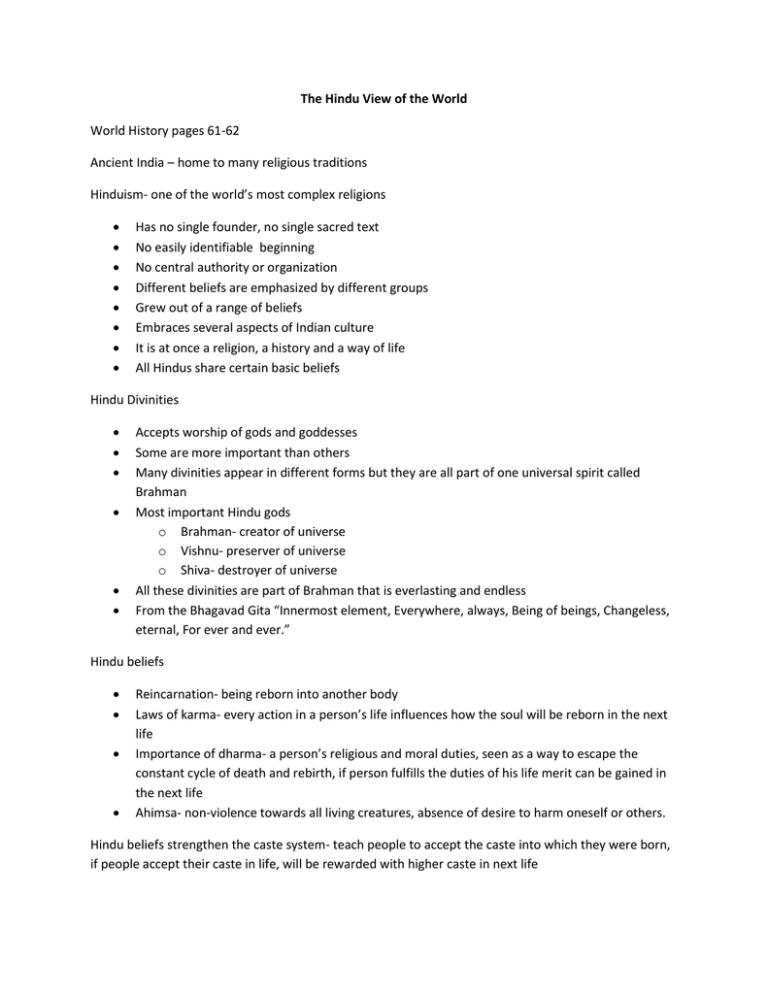
The Hindu View of the World World History pages 61-62 Ancient India – home to many religious traditions Hinduism- one of the world’s most complex religions Has no single founder, no single sacred text No easily identifiable beginning No central authority or organization Different beliefs are emphasized by different groups Grew out of a range of beliefs Embraces several aspects of Indian culture It is at once a religion, a history and a way of life All Hindus share certain basic beliefs Hindu Divinities Accepts worship of gods and goddesses Some are more important than others Many divinities appear in different forms but they are all part of one universal spirit called Brahman Most important Hindu gods o Brahman- creator of universe o Vishnu- preserver of universe o Shiva- destroyer of universe All these divinities are part of Brahman that is everlasting and endless From the Bhagavad Gita “Innermost element, Everywhere, always, Being of beings, Changeless, eternal, For ever and ever.” Hindu beliefs Reincarnation- being reborn into another body Laws of karma- every action in a person’s life influences how the soul will be reborn in the next life Importance of dharma- a person’s religious and moral duties, seen as a way to escape the constant cycle of death and rebirth, if person fulfills the duties of his life merit can be gained in the next life Ahimsa- non-violence towards all living creatures, absence of desire to harm oneself or others. Hindu beliefs strengthen the caste system- teach people to accept the caste into which they were born, if people accept their caste in life, will be rewarded with higher caste in next life Hinduism (People and Culture Series) Caste system firmly interwoven with Hinduism Has no founder, evolved over centuries No central doctrine or set of rituals Something in Hinduism for everyone What is known about it from books known as Vedas (Veda meaning wisdom) 4 Books make up Hindu bible o Rig Veda-religious poetry- oldest and most sacred book o Yajur Veda- guide to religious ritual o Atharva Veda- chants and instructions concerning the casting of magical spells o Sama Veda- collection of hymns The Brahmanas are a group of writings that explain how to perform various Vedic rituals. The Aranyakas and Upanishads are philosophy texts that explain the inner significance of the Vedic rites Eventually recorded in Sanskrit, books indicate the Aryans were singing, dancing, gambling, worshipped gods in nature, consider water sacred By 1000 BC-achieved agricultural way of life, gods varied Brahma the Creator, Shiva the Destroyer, Vishnu the Preserver, Brahman- Supreme Being, Atman-World Spirit Two long epic poems o Mahabharata- tells of the great civil war in NW India, Rama and Krishna central character in this poem, in actuality they were the god Vishnu the Preserver in the form of man, Vishnu has appeared on earth in 9-10 existences, illustrates in dramatic form how good Hindus should live, characters are constantly facing tough moral issues and having to make difficult choices o Ramayana- tells of feats of Rama- an Aryan prince, epic literature around since 700 BCE Honored many gods Enshrined images in temples and other holy places Refuse to eat meat Upheld caste system Forces of Destiny Dharma- moral duty, also means obedience to rules of duty and conduct Reincarnation- upon death creature’s soul assumes another form also called transmigration of souls Hindu thinking- soul is timeless, birth and death not beginning and end, death represents leaving one body for another Karma- moral consequences of an act, fate or destiny, determined by actions in previous life Reality lies only in spiritual not material things Dharma depends on caste to which one belongs Highest purpose in life is to live in such a way that he can cross over this cycle of existence and untie his soul with Brahman-Atman- thus he attains moksha or salvation- releases him from the cycle of birth and rebirth Purple Photocopy 37-40 Brahmanism Gods of Aryans Agni – god of fire- great brawling figure Indra- wielder of thunderbolt and god of war, each year slew a dragon to release monsoon rains Rudra- divine archer who spread disaster and disease Varuna- god of order in the universe, hard god, quick to punish those who sinned and upset the balance of nature Ushas- goddess of dawn, gentle deity welcomed birds, gave delight to humans, warded off evil spirits Core of belief (Upanishads composed between 750-500) - shift from mythical to philosophical Focused on sacrifice, belief that proper sacrifice would force a god to grant worshipper’s wish Shift towards asceticism- severe self- denial and self- discipline Belief that meditation on ritual sacrifice could produce same results as the physical ritual itself Ancient Indian cosmology – not focused on creator but on endlessly repeating cycles Key ideas: Samsara-transmigration of souls by continuous process of rebirth Karma- The tally of good and bad deeds that determine status of individual’s next life Wheel of life- includes all humans, animals and gods, cycle of birth and death No all-knowing god Individual responsible for own destiny in an impartial world For some ideas attractive- hope for better life, for others- endless cycle of birth and deathyearn for release One solution- moksha- release from the wheel of life, one must realize that ultimate reality was unchanging o This unchanging called Brahman- the multitude of things in the world is fleeting, the only true reality is this unchanging called Brahman, all people have inside of themselves the eternal truth that corresponds to a greater all-encompassing reality These doctrines were intellectually revolutionary, in social and political terms they supported the existing power structure. Through Indian Eyes-pages 107-128 According to Hindu worldview- two stages in the first half of life- the student and the householder It is here a person is guided by: Dharma- through Dharma Hindus carry out their student, family and work responsibility, moral duty, role by caste and stage of life Kama- through Kama Hindus fall in love and reproduce Artha- through Artha Hindus pursue success Samsara- everyday world of pain and joy, work and success, birth and death and death is but one point on the great span of endless time Hindus do not live for this world alone; they recognize a fourth and final goal of life- moksha Moksha-reunion with the divine- this is the only goal of the second half of life In pursuit of moksha there are two more stages of life o Going into the forest- this is where Hindus break free from their karma, their fate that locks them into endless rounds of birth and rebirth which keep them mired in the tediousness of samsara o Different people use different paths or yogas in their striving for moksha o The wandering holy man- final stage of life, few Hindus reach this stage, culmination of life Death- one point on great span of time Individual may die but his life source or soul (atman) never dies Takes on new form with each birth Rebirth called Samsara- this is the certainty for Hindus on which all life is based Karma Factor that determines the form in which you will be born in your next existence Good life builds Good karma- next life higher station and happier life Good and bad karma built up over generations, the balance being passed onto future lives, it is the balancing of good and bad deeds over hundreds of lifetimes Quote from Upanishads-page 110 Karma helps explain the seeming unfairness of life , quote page 111 Living is an attempt to build good karma Cause and effect, consequences Fate and destiny strongly determined by adherence to dharma in previous life Build good karma by doing one’s duty- one’s dharma Each person has a dharma determined in part by position in family, caste, and age Each must be faithful to his own dharma Brahman: The Hindu Concept of God Final goal for Hindus not to be born into higher station in next life but not to be born again at all Hindus grow weary of living on earth- quote page 112 This is when we are ready to seek reunion with God Hindu concept of God- quote 112-113 Source of all Single source is invisible Pervades all things It is Oneness with reality To be the ONE, it must combine all opposites within itself In Judeo-Christian tradition and Islam- God is good, Devil is evil For Hindus- ultimate reality is both Rig Veda 1:64 o They call Him Indra, Mitra, Varun,Agni. o They call Him Garutman. o They call Him Yama and Matarishvan. o There is one God; He is known by many names. What is the relationship to God? Story page 113-114 Christians and Muslims believe that man stands in relationship to God Hindus believe all things are God and therefore man is God too, yet god is not you Story of six blind men and elephant Perception of physical phenomena are real is called MAYA- (root word for magic- means illusion) In Hinduism- one must go past these material forms to the one divine mystery that envelops and manifests itself as all the little realities. It is the one true reality. MAYA is the mistaken belief that lesser things are real. We spend our time loving and fighting things that are illusionary Example- story of the kitten Moksha: Seeking Reunion with Brahman We live in the world of MAYA- experiencing life as separate beings We begin to yearn for something deeper Artha and Kama no longer tempt us- quote page 116 What then? We are ready to give up our roles and seek Brahman- the Oneness of all things Clear instructions on how to do this – quote page 117 Going into the forest- the individual personality (the ego) disappears Story of king Bharata- page 117-118, another story page 118-120 Yoga: Paths to the One Seeking union with the ONE – many paths Requirements- sincerity, dedication, years of discipline Yoga means “yoking to God” or union with God There are a variety of means to experience moksha, becoming selfless and egoless Involves total dedication Yoga is a long process, involves attitude rather than technique Three major yogas: 1. Raja- yoga Seeking god through meditation and proper knowledge Intentional stopping of the spontaneous activities of the mind stuff Our minds are constantly on the move, it is restless and hard to train Constant practice and by freedom from passions the mind can be trained Training to control the mind, stop its images and associations so a deeper level of reality can be experienced Divided into 8 stages Self- control- practice of the five moral rules- non -violence, truthfulness, not stealing , chastity, avoidance of greed Observance- regular and complete observance of the five rules Posture- sitting in certain postures essential to meditation, most famous- Lotus position Control of breath- respiration is forced into unusual rhythms, believe to be of great physical and spiritual value Restraint- Organs are trained to take no note of their perceptions Steadying the Mind- by concentrating on a single object Meditation- the object of concentration fills the whole mind Deep meditation- when the whole personality is temporarily dissolved Story of warrior in Bhagavad Gita- Arjuna 2. Karma yoga Based on action Requires one to act without regard for fruits of one’s actions Example of mighty warrior pages 122-124 To act with “holy indifference” With no concerns for results Your business is with the deed not the result Mahatma Gandhi believe in karma-yoga No withdrawing from life Life and the world are the stage on which we live out the truth Pure Act- important idea in karma yoga ( $10 example page 125) 3. Bhakti-yoga Surrender completely to God To love God with your complete being Does not require great learning or mastering of scripture or elaborate rituals One does not have to be well born Deity most often associated with this form is Lord Krishna Vishnu, Shiva and Rama are objects of Bhakti worship Also female deities- Lakshmi, Durga, Kali Often associated with saints who through their poetry, songs and way of life bring people to the love of God Ultimate goal: release from the constant round of birth and rebirth (Ghandi quote page 128) Why are we here? To do our duty, because of the past good or evil we have done, no change in this, creator knows all and places you accordingly Pros Contentment Less stress and struggle No envy or jealousy Each strives to do their dharma Punishment of bad behavior beyond control Stability- no class struggle or violence Control Removes self- responsibility Virtue and self- sacrifice- good for the rulers and all Cons No motivation to better one’s position now Western view of luck of of the draw Control Untouchables- contradicts /complements belief in divine Millions of gods, polytheistic vs. monotheistic Gods: Brahma Creator God Self-born 4 heads and alms Shiva, Lord of Dance Dance- movement of the universe Naked sitting on tiger skin with snakes wrapped around his arms, body smeared with ashes Naked- stark reality of self, sits – meditation, ashes – after universe blown away in cosmic dust he is left 2 sided drum- creation, pulse of universe Fire- destruction, leads to creation in fist in left hand Halo of Flame- samsara- reincarnation, life comes from heat, ends in fires of destruction Mudra- lower right hand “Do not be afraid” lower left hand “There is a way out” promise of salvation Raised left foot- release from cycle of birth- new plane of existence Dwarf being crushed- ignorance of moksha Shiva’s hair- Shiva can control nature Destroyer god Vishnu Maintains law and order in universe Takes on any form to do the job, sometimes the human form You can count on his aid when acting to take on benefit of the world Blue , four armed, discus in fingers slices enemies of good and righteousness in two, also holds golden baton that flattens our egos when we get too big for our britches, holds shell represents the OM- primordial sound from which the universe was manifested, holds lotus symbol of purity Avatars are Rama and Krishna Ganesha Son of Shiva and Parvati Elephant head Lost his head guarding door for Parvati’s bath Self- sacrifice Hanuman Monkey head and tail Rama and Sita in his head Killing monkeys is illegal Trinity- personification of Brahman (absolute reality) Brahma- the creator, Vishnu- the protector, Shiva-destroyer/liberator Goddesses: Shaktis- female power Sarasvati Goddess of intellectual and spiritual knowledge 4 hands hold book (knowledge), rosary(source of spiritual knowledge), vina in two hands (musical instrument- source of sound vibrations, goddess of sound waves-energy that formed the universe) Muse Wife of Brahma Lakshmi Goddess of wealth and prosperity, health and harmony Wrapped in red sari, coins stream from her hands, also holds lotuses- not all her greatest boons are material but also spiritual Soft hearted, incapable of punishing anyone Sita with Roma Vishnu’s wife Parvati Way to god Meditates and suffers to win Shiva as husband Shiva as widower- wife- Sati ,kills herself when Shiva not invited to party Shiva wails, Vishnu cuts Sati up Sati reincarnated as Parvati Skull necklace Tongue out Springs from a brief frown of the mother of the world Fights Raktabija Represents internal battles against negative thoughts Kali Hindu Gods and Goddesses Shiva Vishnu Lakshmi Sarasvati Ganesha Kali Parvati
